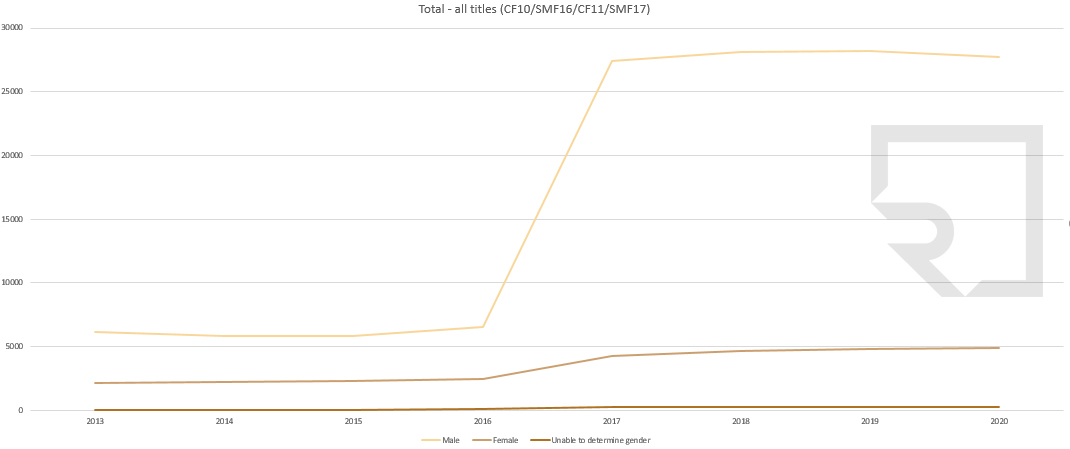As stated in one of our latest articles around increasing diversity within financial services, a recent PwC survey found that “nearly three-quarters of FS industry leaders […] have a strategy to promote diversity and inclusiveness (59%) or plan to adopt one (14%)”.
Given today’s political climate, such results should come as great news, as underrepresented communities are increasingly getting the opportunity to add value to a business and fully get the representation they deserve.
While this study’s results sound great, a question remains: are these only words, or have we really noticed a change in recent years when it comes to addressing diversity and inclusion in the workplace, especially in the compliance and financial crime sectors?
The Gender Gap in Compliance and Financial Crime
As compliance, financial crime and crypto SMF17 recruitment specialists, we can testify that firms are becoming much more aware of the importance of diversity in the recruiting process. We have seen a significant increase of businesses asking recruitment partners engaged in a search to send a candidates shortlist that provides an accurate portrait of our society.
Such awareness will surely positively impact the future of compliance and financial crime sectors, but it might take a while before we start noticing an actual shift on the market. We recently reached out to the Financial Conduct Authority (FCA) and used a Freedom of Information (FOI) request to see if the promotion of diversity and inclusion policies have had a tangible effect on the gender gap over the past few years. For this FOI, we received numbers and details regarding gender split for individuals who have occupied the CF10/SMF16, CF11/SMF17 or Cf10 & CF11/SMF16 & SMF17 roles since 2013.
Numbers show that we still have a long way to go: in 2020 [1], 84% of individuals who held a CF10 or SMF16 title [2] were men, while only 15% were women. As for the CF11 or SMF17 role within organisations, numbers are quite similar: 83% men and 16% women. The gap becomes even bigger when it comes to individuals holding both functions (CF10/CF11 & SMF16/SMF17): in 2020, 86% of them were men, and only 13% were women.
What is even more surprising is how, up until 2017, the industry was slowly improving on the diversity front: from 2013 to 2016, the gender gap was gently decreasing, going from a 76% men / 24% women split to 73% men / 26% women. In 2017, though, things changed drastically. The FCA’s regulatory envelope increased, with the inclusion of consumer credit firms – and the subsequent need for these to appoint SMFs where they had the relevant debt permissions.
The impact of this addition to the regulatory pool can’t be ignored when talking about diversity: the total number of men occupying a CF10, CF11, SMF16 and/or SMF17 role increased by 316.17% 2017, against a 74.45% increase for women.
The heavily male-dominated sector of consumer credit has therefore brought the gender gap backwards: the split switched to 87% men versus 12% women that in 2017.

Such figures should hopefully spark questions within professionals in our sector: are implemented D&I strategies robust enough? How long will we have to wait before seeing results of these strategies?
Asking a recruiting partner to diversify its shortlist is a first step in the right direction, but ticking that box isn’t necessarily going to result in change. Out of the diversified pool, who ends up getting the job? Is this where the D&I strategy fails? How can firms guarantee that candidates who make it through the finish line are an accurate representation of the shortlist companies were given in the first place?
Numbers through the years
The numbers provided by the FCA clearly indicate than men continue to hugely outnumber women in compliance and financial crime. As seen below, since 2013, the lowest gap was in 2015, when 70% of individuals holding the CF11/SMF17 function were men, against 29% for women.
While D&I isn’t a box ticking exercise, it should definitely be at the forefront of a business’ agenda if it wants to play catch up with current times. 2020 has shown the world how omitting to embrace diversity and inclusion within a corporation can negatively impact consumers’ brand perception – and ultimately, profits.
1: Figures have been taken from a snapshot in time as a person could hold a controlled function on Jan 1st in a given year, but not by the end of the year. Therefore, it is not possible to display the figures for a whole year.
2: On 9 December 2019, the SMCR was extended to the majority of FCA solo-regulated entities and therefore, functions previously held under the Approved Person Regime were in many cases converted to the corresponding functions under the SMCR.
Contact
Genevieve Higgins-Desbiens is Marketing Manager at Rutherford, the legal and compliance recruitment specialists.
Contact us for a confidential search within compliance, financial crime and crypto SMF17, send us an email at enquiries@rutherfordsearch.com or see our latest vacancies.
Email: genevieve@rutherfordsearch.com






.png)




